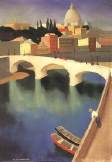

In 1928 the Hungarian state established a new scholarship for young artists in the Hungarian Academy in Rome: scholarship holders stayed and worked in Italy for a year or two. The scholarship system established by Tibor Gerevich, an art historian and also the curator of the project, was intended for young Hungarian artists to meet recent Italian art instead of French or German in order to create a new art style.
Artists of the first years were influenced by various experiences. Tempera technique rediscovered by Károly Patkó resulted in previously dark tones fading into light ones and more colourful pictures, subject matters were taken from everyday life. The real change is best demonstrated in Concert in the Square by Vilmos Aba-Novák. Landscapes with Mediterranean structure are accompanied with expressive colours of monumental form (e.g. Károly Patkó: Cefalú).
The other group of the Roman school was strongly influenced by periods of Italian style: archaic elements recalling trecento together with modern trends are present in these pictures. Paintings on religious subjects by Pál C. Molnár reflect the influence of art deco (Madonna), nudes of Jenő Medveczky strict archaism (Composition with Three Figures) and pictures of Béla Kontuly with portraits or groups showing the influence of Neue Sachlichkeit (Marriage in Cana). Several artists were commissioned to produce panel pictures or frescoes for churches (Vilmos Aba-Novák: Last Judgement, Jenő Medveczky: Resurrection of Christ).